Did you know carrot microgreens can be ready in just 15 days? They are one of the slowest to grow but are packed with flavor and health benefits. This guide will help you grow your own homegrown carrot sprouts.
Carrot sprouts are not only pretty but also crunchy and nutritious. They are full of vitamins and can be used in many dishes. Growing them at home is a rewarding and healthy activity.
Table of Contents
Introduction to Carrot Microgreens
Carrot microgreens are the young, tender shoots of the carrot plant. They are ready to eat in just 15 to 25 days. Unlike full-grown carrots, which take much longer to mature, these microgreens offer a quick burst of flavor and nutrients.
Their mild, earthy taste makes them a great addition to many dishes. They add color and nutrition without overpowering other flavors.
Organic carrot sprouts have become very popular in recent years. This is thanks to their ease of growth, allowing people to grow their own nutrient-rich greens at home. Carrot microgreens are full of vitamins A and K, which are important for health.
They also have a lot of dietary fiber, minerals, and antioxidants. These help fight oxidative stress.
- High in vitamin A (835 mg, 92.8%) for vibrant health
- Contains vitamin K (13.2 mg, 10.8%) for bone strength
- Loaded with antioxidants to potentially reduce chronic disease risks
- Delivers essential amino acids aiding protein synthesis
Carrot microgreens are not just good for your diet. They also help keep your eyes healthy because of their beta-carotene. You can add them to salads, smoothies, or use them as a garnish. Using carrot microgreens can open up new possibilities in cooking and boost your nutrition.
Understanding the Nutritional Benefits of Carrot Sprouts
Carrot sprouts are not just tasty; they’re also super nutritious. They’re full of vitamins and minerals that are great for your health. They’re a top pick for anyone looking to eat more nutrients.
High Vitamin Content
Carrot sprouts are known for their high vitamin content. They have lots of vitamins A, C, and K. Vitamin A is good for your eyes and immune system.
Vitamin C helps your skin stay healthy. Vitamin K is important for blood to clot properly. Eating carrot microgreens can help you get more veggies in your diet.
Rich in Antioxidants
Carrot sprouts also have lots of antioxidants like beta-carotene and lutein. These fight off oxidative stress and keep you healthy. Antioxidants can lower the risk of chronic diseases.
Eating these sprouts often can improve your eye health. This makes them a key part of a healthy diet.
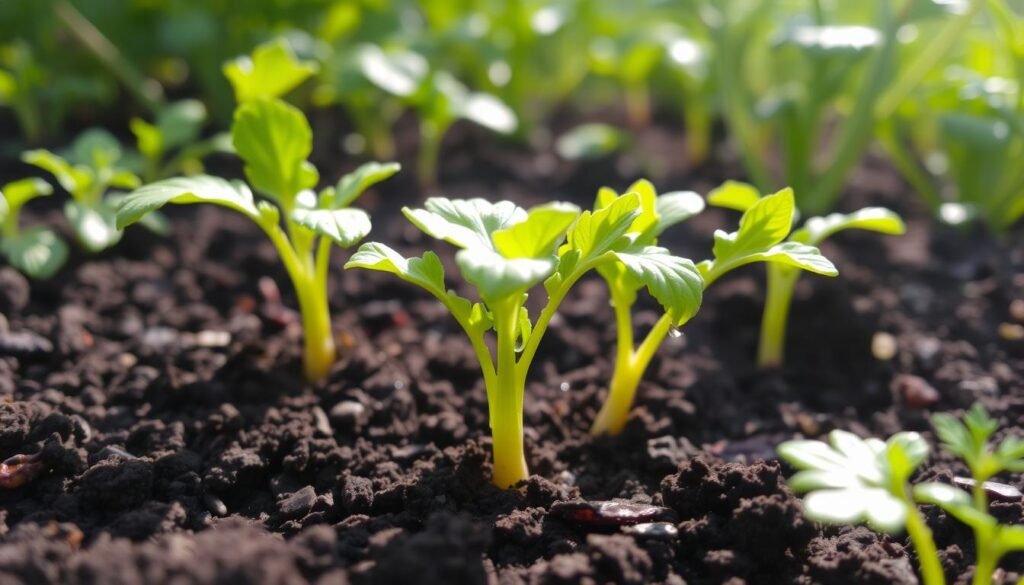
| Nutritional Component | Amount per 100g | Health Benefits |
|---|---|---|
| Calories | 41 | Low-calorie option for weight management |
| Vitamin A | over 800mcg | Supports vision and immune function |
| Vitamin C | 7.6mg | Boosts skin health and immune response |
| Fiber | 2.7g | Supports digestive health |
| Potassium | 237mg | Helps maintain healthy blood pressure |
Selecting the Right Carrot Seed Varieties
Choosing the right carrot seed varieties is key for a successful crop of carrot seed sprouts. Many options are popular, each with its own traits and needs. Knowing these will help you pick the best for your garden and taste.
Popular Carrot Seed Choices
Some of the most popular varieties include:
- Danvers: It has a nearly 100% germination rate and takes about 70 days to mature.
- Purple Haze: Ready in about 73 days, it’s known for its bright color.
- Cosmic Purple: It has a deep color and lots of antioxidants.
- Scarlet Nantes: It grows in 65 to 75 days and is great for cooking.
- Rainbow Blend: A mix of colors and tastes, including Cosmic Purple, Solar Yellow, Lunar White, and Atomic Red.
Factors to Consider When Choosing Seeds
When picking seeds for organic carrot sprouts, remember these points:
- Germination Rate: Go for high germination rates like Danvers.
- Flavor Profile: Pick spicy like Dragon or sweet like Lunar White based on your taste.
- Environmental Conditions: Think about your planting zone and climate for best growth.
- Time to Maturity: Some carrots are ready in 50 days, others in 85 days.
- Seed Quality: Opt for organic for a chemical-free garden.
Understanding popular carrot seed choices and key factors will help you grow a bountiful garden. Your garden will be filled with tasty, healthy microgreens.
Container and Soil Requirements for Growing Carrot Sprouts
Choosing the right container and soil is key to growing carrot sprouts. The container’s drainage is vital for healthy roots. The soil mix also impacts germination and growth. Carrots can grow in many containers, giving growers flexibility.
Best Type of Containers
When picking containers, consider specific needs. Carrots can grow in several types, including:
- 10-gallon grow bags (about 16 inches across), good for 24 to 36 carrots.
- Fabric pots that breathe and control moisture.
- Upcycled 5-gallon plastic buckets for sustainability.
- Large clay pots (13 inches diameter, 12 inches deep) for root growth.
- Rectangular containers (55 cm long, 20 cm wide, 20 cm deep).
Each container needs drainage holes and space for carrot roots. Thinning seedlings is important, spacing them 1 1/2 to 3 inches apart for best growth.
Choosing the Right Soil Mix for Microgreens
The soil for carrot sprouts must drain well but hold moisture. A good mix is a fine seed-starting mix or a mix of potting soil and coco coir. Keeping the soil pH at 6.0 to 6.8 helps with nutrient uptake. Consider these factors when picking your microgreens soil mix:
- Texture and consistency for drainage.
- Ability to hold moisture without being too wet.
- Organic content for better nutrients.
Lightly dust seeds with soil at 1/8-1/4 inch depth for high germination. Keep the soil moist but not flooded to avoid root problems. Soil temperature should be between 55 and 75 degrees Fahrenheit for best germination.
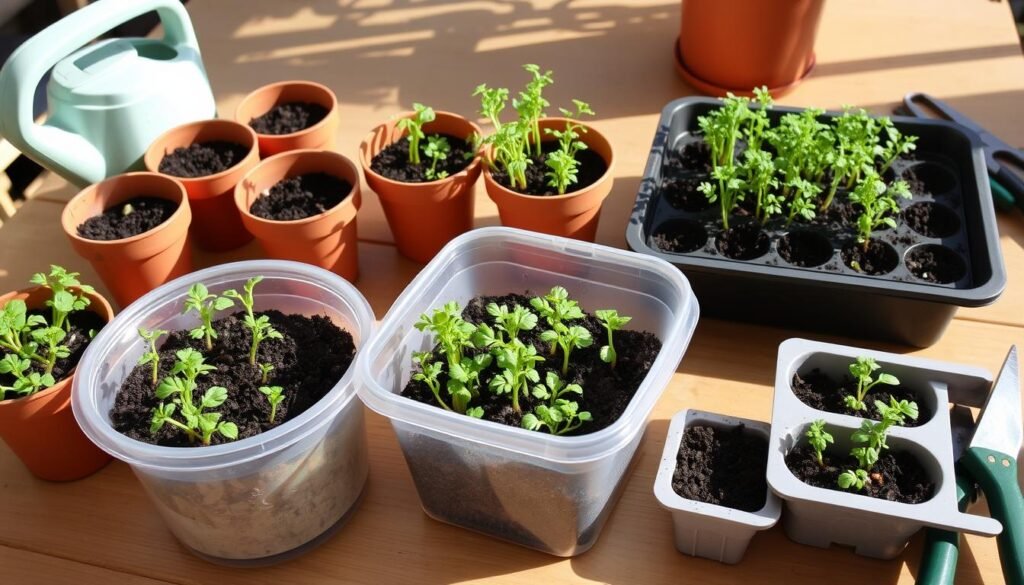
| Container Type | Size | Carrots Capacity |
|---|---|---|
| 10-Gallon Grow Bag | 16 inches across | 24-36 carrots |
| Large Clay Pot | 13 inches diameter, 12 inches deep | Suitable for various root lengths |
| Rectangular Container | 55 cm long, 20 cm wide, 20 cm deep | Adequate for multiple plants |
| Upcycled 5-Gallon Bucket | Standard bucket size | Varies with carrot variety |
Optimal Growing Conditions for Carrot Microgreens
To grow healthy carrot microgreens, you need the right conditions. Make sure they get enough light, the right temperature, and the right humidity. This will help you succeed in growing these nutritious sprouts.
Light Requirements
Carrot sprouts need specific light conditions. They do best with 12 to 16 hours of light each day. Use grow lights 1 to 3 feet above the plants to prevent them from getting too long.
Consistent light helps them grow strong and absorb nutrients better.
Temperature and Humidity Considerations
The best temperature for growing carrot sprouts is between 65°F and 75°F (18°C to 24°C). Keeping this temperature helps them grow well. Also, keeping the humidity moderate is key to prevent mold and other problems.
Good air circulation in the early stages helps them thrive. This creates a healthy environment for your carrot microgreens to grow.
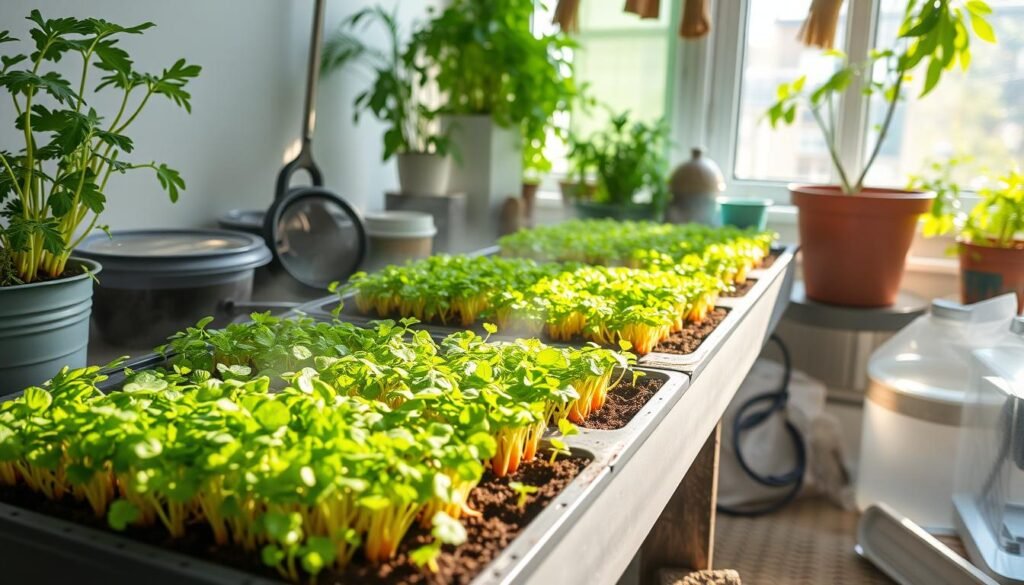
Planting Techniques for Carrot Sprouts
Getting carrot sprouts to grow well starts with the right planting techniques. Whether you’re new to gardening or have lots of experience, knowing how to plant carrot seeds is key. It’s the first step to a successful harvest.
How to Spread Seeds Evenly
Evenly spreading carrot seeds is important. They’re small, so placing them one by one is hard. A good trick is to use a salt shaker to spread them evenly over the soil. This way, you avoid overcrowding.
After spreading, press the seeds gently into the soil. Make sure they’re only 1/4 inch deep. This helps them get enough moisture. Planting them about an inch and a half apart helps them grow well without competing with each other.
Importance of a Blackout Period
After planting, a dark period helps carrot seeds sprout better. This usually lasts 5 to 7 days. Cover the seeds with a tray to keep them dark. This dark time helps them sprout like they would in nature.
Once they start sprouting, usually by day 5 or 6, remove the tray. Letting them get some light is important for their growth.
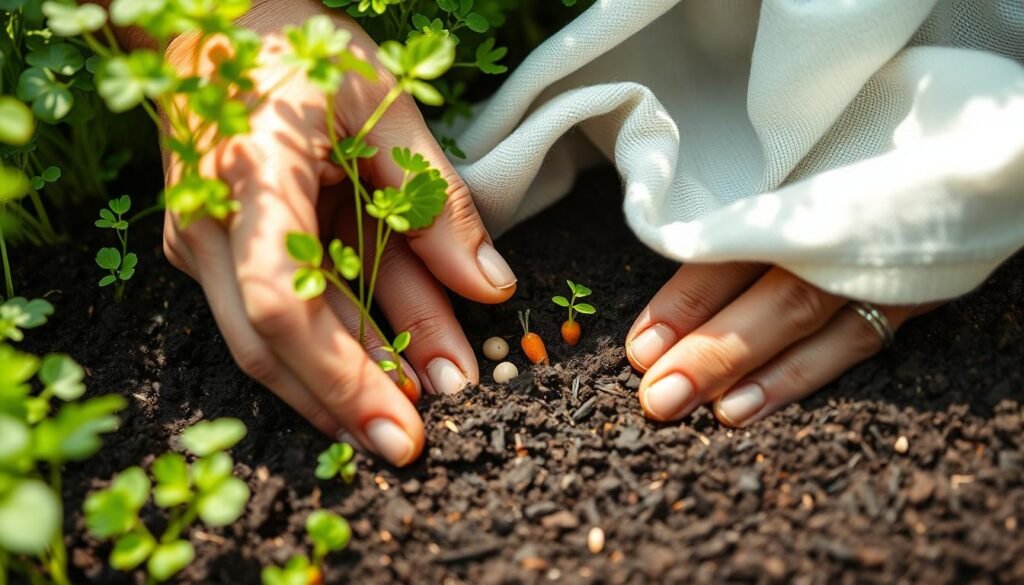
| Planting Steps | Details |
|---|---|
| Preparation | Water the soil before planting to prevent seed washout. |
| Seed Spacing | Place seeds 1/4 inch deep and 1.5 inches apart. |
| Blackout Period | Cover with a tray for 5-7 days post-planting. |
| Germination Check | Check for sprouts around day 5 or 6. |
| Light Exposure | Remove the covering once sprouts appear. |
By following these steps, your carrot seeds will have the best chance to grow well. This leads to a bountiful harvest.
Caring for Your Carrot Microgreens
Keeping your carrot microgreens healthy is key to their growth. Knowing how to water and fight pests is important. These steps can make a big difference in your success.
Watering Techniques for Healthy Growth
Watering your carrot microgreens right is critical. Try bottom-up watering, where you put the tray in a shallow water dish. This method lets the soil soak up water without getting the leaves wet. It helps avoid fungal infections.
Keep the soil moist but not too wet. Adjust your watering based on the environment. Carrot microgreens do best with consistent moisture.
Dealing with Common Pests and Diseases
Managing pests is essential for caring for carrot sprouts. Aphids and mold can harm your plants. Use natural solutions like neem oil to fight pests.
Good airflow helps prevent mold. Also, use clean containers and quality soil to avoid diseases. This includes damping-off, which likes warm, humid places.
| Aspect | Recommendations |
|---|---|
| Watering Method | Bottom-up watering in a shallow dish |
| Pest Management | Use neem oil and ensure proper airflow |
| Soil Maintenance | Utilize clean containers and quality potting soil |
| Moisture Levels | Maintain consistent moisture, avoid overwatering |
Harvesting Your Carrot Sprouts
Harvesting carrot sprouts at the right time is key for the best taste and health benefits. They are ready to pick when the first true leaves start to show, usually 15 to 25 days after planting. This ensures you get the most out of these nutritious greens.
When to Harvest for Best Flavor
Knowing when to harvest is essential for the best flavor. Look for the leaves to be well-defined, which happens two to four weeks after planting. Harvesting at this stage will give you the most flavorful sprouts. Waiting too long can make them taste bitter, which isn’t good for your dishes.
Recommended Harvesting Techniques
For a clean harvest, use sharp kitchen scissors. Cut just above the soil line to avoid damaging the roots. Remember, carrot sprouts don’t grow back after you pick them. After harvesting, you can compost the soil to prepare it for the next batch of plants.
Storing Fresh Carrot Sprouts for Maximum Freshness
Keeping your carrot sprouts fresh is key. Proper storage helps keep their taste and nutrients intact. With the right tips, you can enjoy them for longer.
Best Practices for Storing Microgreens
Storing carrot microgreens right involves a few important steps:
- Refrigeration is best. Keep your sprouts in a sealed bag in the fridge until you’re ready to eat them. This prevents moisture buildup.
- Stay away from fruits like bananas and apples. They can make your sprouts spoil faster.
- If you have too many sprouts, freezing is a good option. They can stay fresh for up to six months this way.
How to Keep Sprouts Crisp and Fresh
Keeping sprouts fresh can be a challenge. Here are some tips to help:
- Always check your sprouts for any signs of spoilage. Throw away any that are moldy or soft.
- Use storage that lets air in to reduce moisture. This is important for keeping sprouts crisp.
- Drying can also preserve your microgreens. But, it changes their texture and taste.
Using Carrot Microgreens in Your Diet
Carrot microgreens are a great addition to many dishes. They bring unique flavors and a burst of color. You can add them to many meals, enjoying their nutritional benefits.
Additive Uses in Salads and Dishes
Carrot microgreens are perfect for salads and other dishes. Sprinkle them on salads for a crunchy texture and extra nutrition. They also add flavor to wraps and sandwiches without overpowering other ingredients.
Use them as a garnish for soups to add color and a surprising taste. They’re great in grain bowls, mixing well with other veggies and proteins.
Creative Recipes Featuring Carrot Sprouts
Try new recipes with carrot sprouts to explore different flavors. Blend them into pesto for a unique twist. They’re also good in smoothies, boosting nutrition without changing the taste.
Make a colorful spring roll with carrot sprouts and other veggies. This adds nutrients and beauty to your meals. The possibilities are endless for using sprouts in your cooking, making your dishes healthier and more interesting.
Conclusion
Growing carrot sprouts at home is a great way to add nutrition to your meals. These microgreens are packed with nutrients, making them a fantastic addition to any dish. You can enjoy them raw in salads or cooked in your favorite recipes.
Starting your gardening journey with carrot sprouts is easy. They grow quickly and need little care, perfect for beginners and experts. Growing your own microgreens brings the joy of fresh produce right to your kitchen.
The hard work of growing carrot sprouts is worth it. It not only improves your meals but also supports sustainable living. Start your gardening adventure today and savor the fresh taste of homegrown carrots.

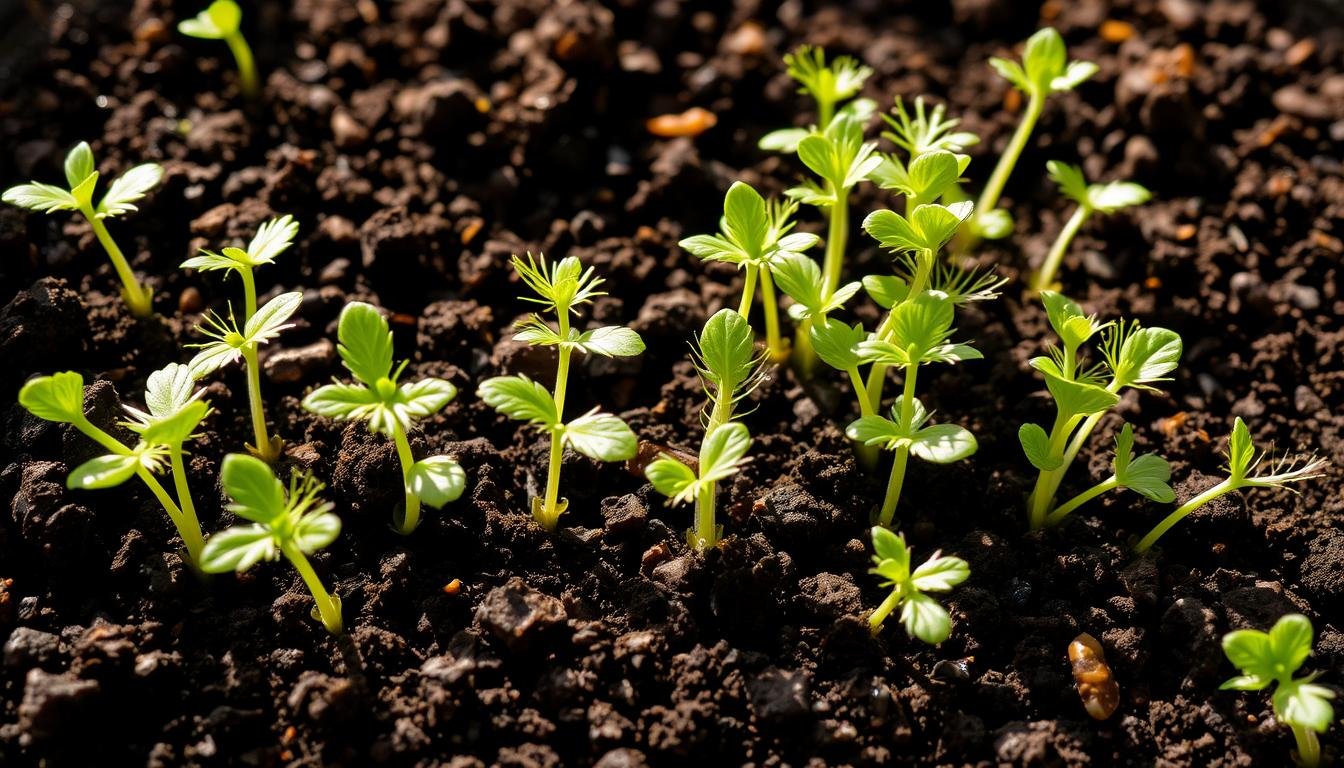
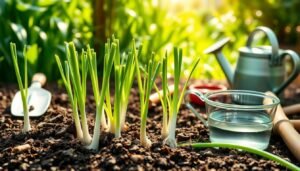

Pingback: When to Plant Potatoes: Best Growing Time Guide
Pingback: Growing Mexican Heather Plant: Care and Benefits